Business Environment Analysis: ABC Consultants - Business Report
VerifiedAdded on 2020/07/23
|13
|3956
|105
Report
AI Summary
This report provides a comprehensive analysis of the business environment faced by ABC Consultants, a UK-based recruitment consultancy. It begins with an introduction to the business environment, differentiating between micro and macro factors. The report then delves into the organizational structure of ABC Consultants, outlining the functions of various departments such as marketing, sales, product development, and operations, and their interrelationships. Task 2 focuses on the macro environment, utilizing the PESTLE framework to identify political, economic, socio-cultural, technological, environmental, and legal factors impacting the company. The report also includes a SWOT analysis to assess the internal strengths and weaknesses, as well as external opportunities and threats. The report emphasizes the positive and negative impacts of these environmental factors on the company's operations and decision-making processes, providing a detailed understanding of the challenges and opportunities within the business landscape. The report concludes by summarizing the key findings and implications for ABC Consultants.

BUSINESS
ENVIRONMENT
ENVIRONMENT
Paraphrase This Document
Need a fresh take? Get an instant paraphrase of this document with our AI Paraphraser
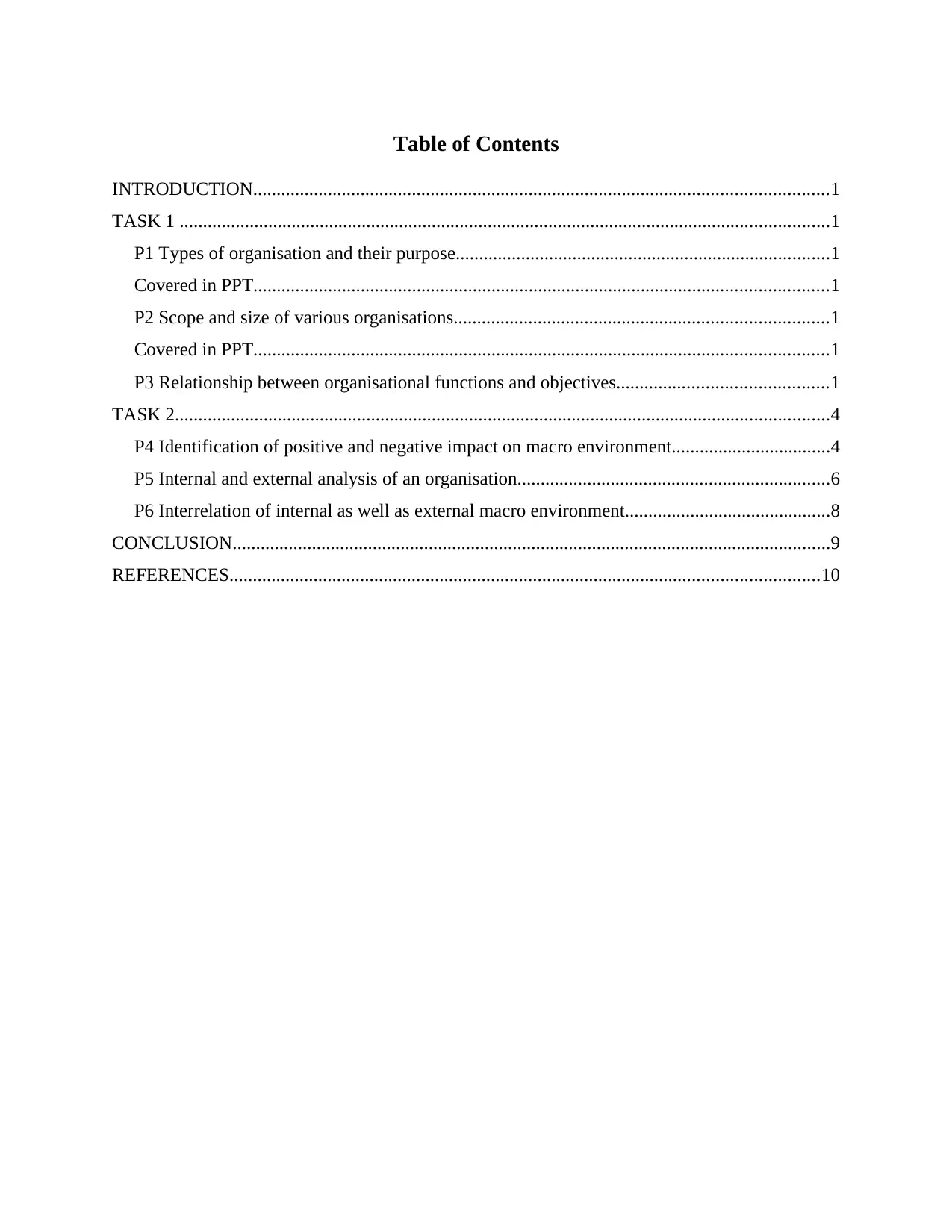
Table of Contents
INTRODUCTION...........................................................................................................................1
TASK 1 ...........................................................................................................................................1
P1 Types of organisation and their purpose................................................................................1
Covered in PPT...........................................................................................................................1
P2 Scope and size of various organisations................................................................................1
Covered in PPT...........................................................................................................................1
P3 Relationship between organisational functions and objectives.............................................1
TASK 2............................................................................................................................................4
P4 Identification of positive and negative impact on macro environment..................................4
P5 Internal and external analysis of an organisation...................................................................6
P6 Interrelation of internal as well as external macro environment............................................8
CONCLUSION................................................................................................................................9
REFERENCES..............................................................................................................................10
INTRODUCTION...........................................................................................................................1
TASK 1 ...........................................................................................................................................1
P1 Types of organisation and their purpose................................................................................1
Covered in PPT...........................................................................................................................1
P2 Scope and size of various organisations................................................................................1
Covered in PPT...........................................................................................................................1
P3 Relationship between organisational functions and objectives.............................................1
TASK 2............................................................................................................................................4
P4 Identification of positive and negative impact on macro environment..................................4
P5 Internal and external analysis of an organisation...................................................................6
P6 Interrelation of internal as well as external macro environment............................................8
CONCLUSION................................................................................................................................9
REFERENCES..............................................................................................................................10
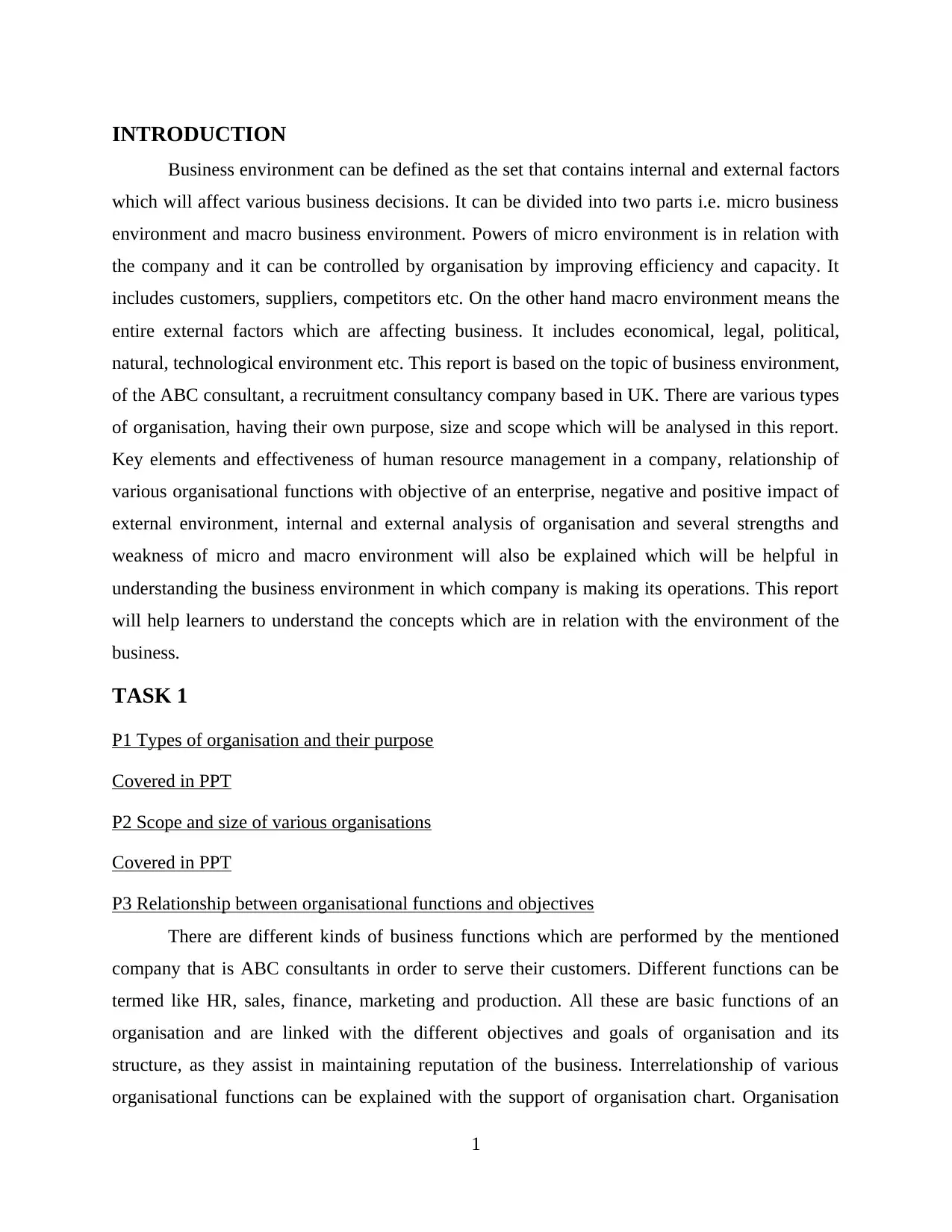
INTRODUCTION
Business environment can be defined as the set that contains internal and external factors
which will affect various business decisions. It can be divided into two parts i.e. micro business
environment and macro business environment. Powers of micro environment is in relation with
the company and it can be controlled by organisation by improving efficiency and capacity. It
includes customers, suppliers, competitors etc. On the other hand macro environment means the
entire external factors which are affecting business. It includes economical, legal, political,
natural, technological environment etc. This report is based on the topic of business environment,
of the ABC consultant, a recruitment consultancy company based in UK. There are various types
of organisation, having their own purpose, size and scope which will be analysed in this report.
Key elements and effectiveness of human resource management in a company, relationship of
various organisational functions with objective of an enterprise, negative and positive impact of
external environment, internal and external analysis of organisation and several strengths and
weakness of micro and macro environment will also be explained which will be helpful in
understanding the business environment in which company is making its operations. This report
will help learners to understand the concepts which are in relation with the environment of the
business.
TASK 1
P1 Types of organisation and their purpose
Covered in PPT
P2 Scope and size of various organisations
Covered in PPT
P3 Relationship between organisational functions and objectives
There are different kinds of business functions which are performed by the mentioned
company that is ABC consultants in order to serve their customers. Different functions can be
termed like HR, sales, finance, marketing and production. All these are basic functions of an
organisation and are linked with the different objectives and goals of organisation and its
structure, as they assist in maintaining reputation of the business. Interrelationship of various
organisational functions can be explained with the support of organisation chart. Organisation
1
Business environment can be defined as the set that contains internal and external factors
which will affect various business decisions. It can be divided into two parts i.e. micro business
environment and macro business environment. Powers of micro environment is in relation with
the company and it can be controlled by organisation by improving efficiency and capacity. It
includes customers, suppliers, competitors etc. On the other hand macro environment means the
entire external factors which are affecting business. It includes economical, legal, political,
natural, technological environment etc. This report is based on the topic of business environment,
of the ABC consultant, a recruitment consultancy company based in UK. There are various types
of organisation, having their own purpose, size and scope which will be analysed in this report.
Key elements and effectiveness of human resource management in a company, relationship of
various organisational functions with objective of an enterprise, negative and positive impact of
external environment, internal and external analysis of organisation and several strengths and
weakness of micro and macro environment will also be explained which will be helpful in
understanding the business environment in which company is making its operations. This report
will help learners to understand the concepts which are in relation with the environment of the
business.
TASK 1
P1 Types of organisation and their purpose
Covered in PPT
P2 Scope and size of various organisations
Covered in PPT
P3 Relationship between organisational functions and objectives
There are different kinds of business functions which are performed by the mentioned
company that is ABC consultants in order to serve their customers. Different functions can be
termed like HR, sales, finance, marketing and production. All these are basic functions of an
organisation and are linked with the different objectives and goals of organisation and its
structure, as they assist in maintaining reputation of the business. Interrelationship of various
organisational functions can be explained with the support of organisation chart. Organisation
1
⊘ This is a preview!⊘
Do you want full access?
Subscribe today to unlock all pages.

Trusted by 1+ million students worldwide
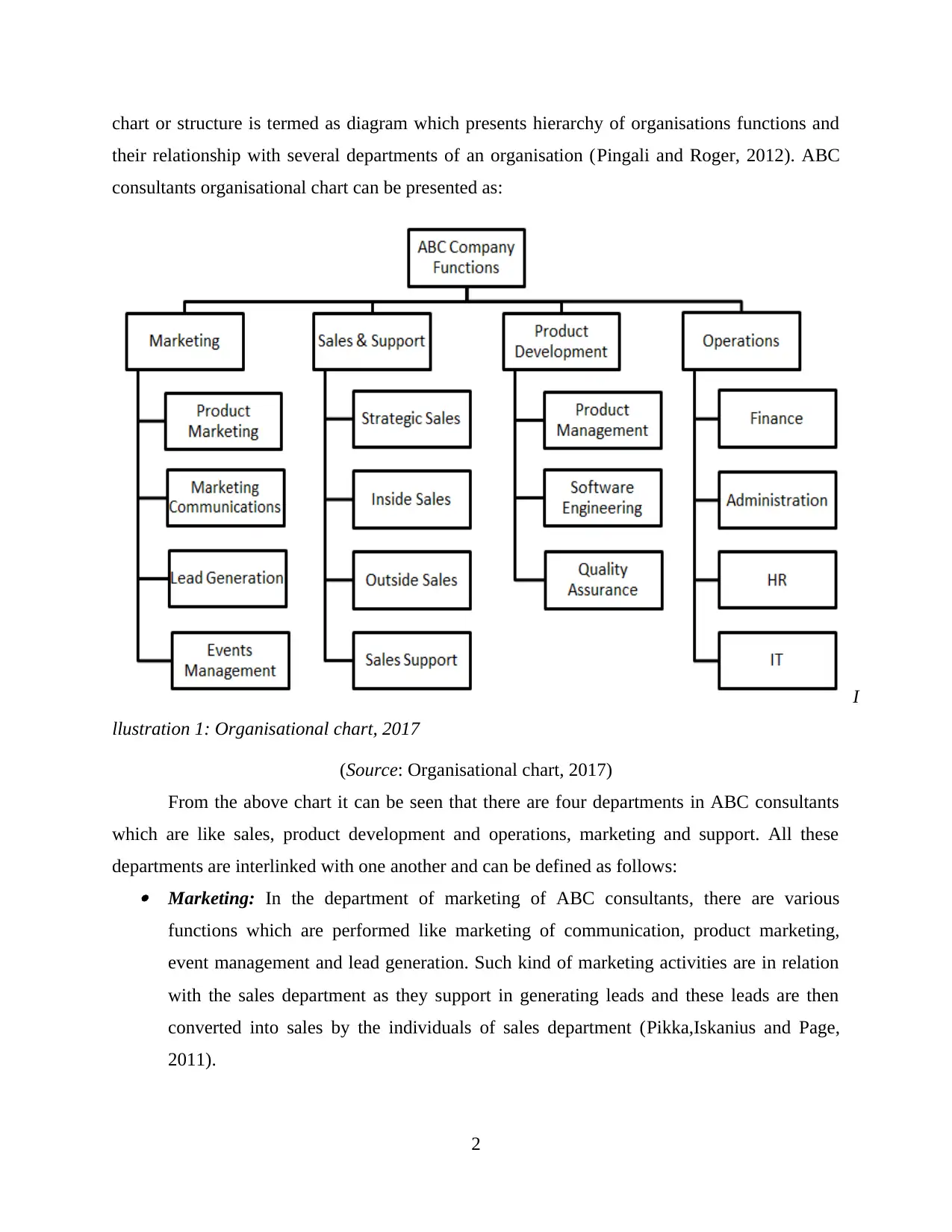
chart or structure is termed as diagram which presents hierarchy of organisations functions and
their relationship with several departments of an organisation (Pingali and Roger, 2012). ABC
consultants organisational chart can be presented as:
I
llustration 1: Organisational chart, 2017
(Source: Organisational chart, 2017)
From the above chart it can be seen that there are four departments in ABC consultants
which are like sales, product development and operations, marketing and support. All these
departments are interlinked with one another and can be defined as follows: Marketing: In the department of marketing of ABC consultants, there are various
functions which are performed like marketing of communication, product marketing,
event management and lead generation. Such kind of marketing activities are in relation
with the sales department as they support in generating leads and these leads are then
converted into sales by the individuals of sales department (Pikka,Iskanius and Page,
2011).
2
their relationship with several departments of an organisation (Pingali and Roger, 2012). ABC
consultants organisational chart can be presented as:
I
llustration 1: Organisational chart, 2017
(Source: Organisational chart, 2017)
From the above chart it can be seen that there are four departments in ABC consultants
which are like sales, product development and operations, marketing and support. All these
departments are interlinked with one another and can be defined as follows: Marketing: In the department of marketing of ABC consultants, there are various
functions which are performed like marketing of communication, product marketing,
event management and lead generation. Such kind of marketing activities are in relation
with the sales department as they support in generating leads and these leads are then
converted into sales by the individuals of sales department (Pikka,Iskanius and Page,
2011).
2
Paraphrase This Document
Need a fresh take? Get an instant paraphrase of this document with our AI Paraphraser
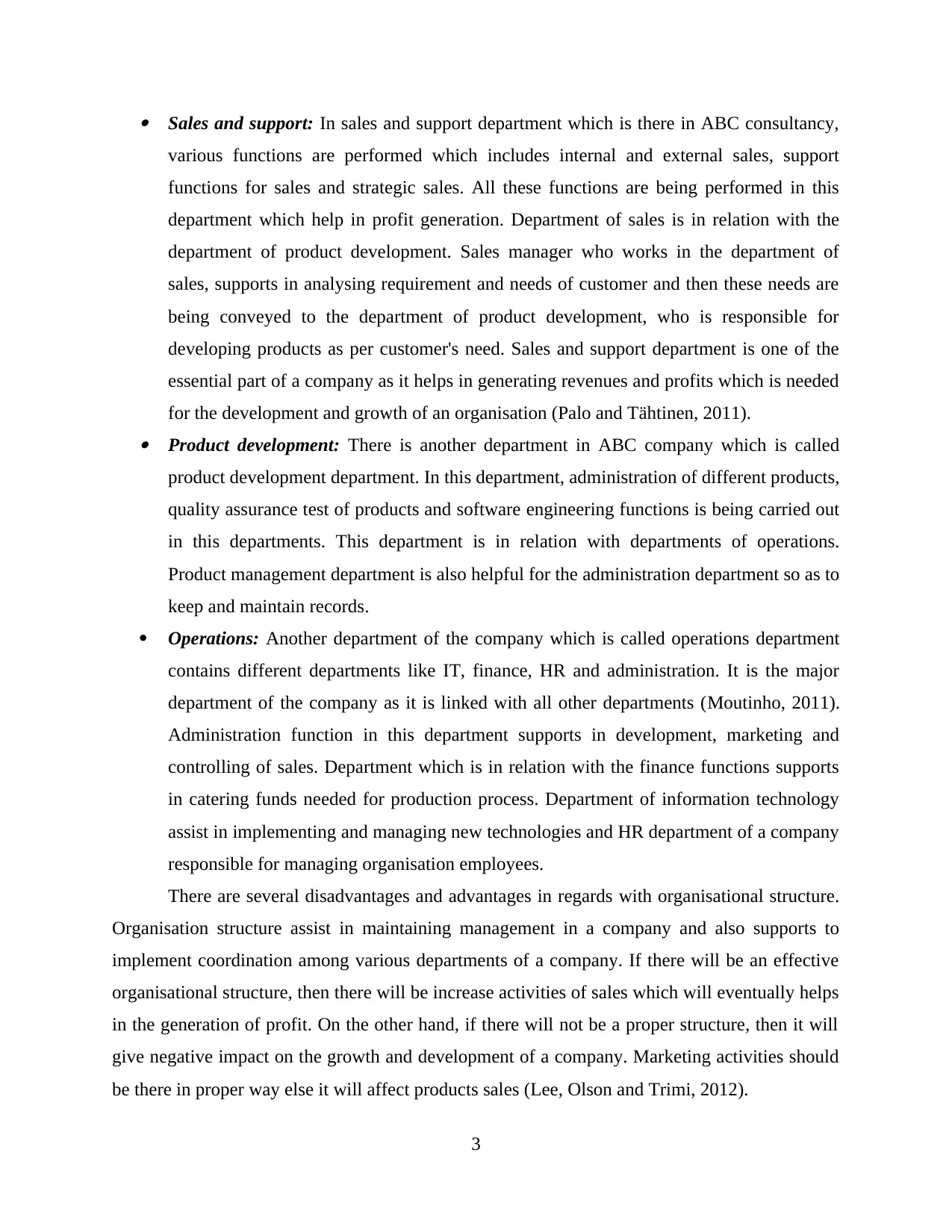
Sales and support: In sales and support department which is there in ABC consultancy,
various functions are performed which includes internal and external sales, support
functions for sales and strategic sales. All these functions are being performed in this
department which help in profit generation. Department of sales is in relation with the
department of product development. Sales manager who works in the department of
sales, supports in analysing requirement and needs of customer and then these needs are
being conveyed to the department of product development, who is responsible for
developing products as per customer's need. Sales and support department is one of the
essential part of a company as it helps in generating revenues and profits which is needed
for the development and growth of an organisation (Palo and Tähtinen, 2011). Product development: There is another department in ABC company which is called
product development department. In this department, administration of different products,
quality assurance test of products and software engineering functions is being carried out
in this departments. This department is in relation with departments of operations.
Product management department is also helpful for the administration department so as to
keep and maintain records.
Operations: Another department of the company which is called operations department
contains different departments like IT, finance, HR and administration. It is the major
department of the company as it is linked with all other departments (Moutinho, 2011).
Administration function in this department supports in development, marketing and
controlling of sales. Department which is in relation with the finance functions supports
in catering funds needed for production process. Department of information technology
assist in implementing and managing new technologies and HR department of a company
responsible for managing organisation employees.
There are several disadvantages and advantages in regards with organisational structure.
Organisation structure assist in maintaining management in a company and also supports to
implement coordination among various departments of a company. If there will be an effective
organisational structure, then there will be increase activities of sales which will eventually helps
in the generation of profit. On the other hand, if there will not be a proper structure, then it will
give negative impact on the growth and development of a company. Marketing activities should
be there in proper way else it will affect products sales (Lee, Olson and Trimi, 2012).
3
various functions are performed which includes internal and external sales, support
functions for sales and strategic sales. All these functions are being performed in this
department which help in profit generation. Department of sales is in relation with the
department of product development. Sales manager who works in the department of
sales, supports in analysing requirement and needs of customer and then these needs are
being conveyed to the department of product development, who is responsible for
developing products as per customer's need. Sales and support department is one of the
essential part of a company as it helps in generating revenues and profits which is needed
for the development and growth of an organisation (Palo and Tähtinen, 2011). Product development: There is another department in ABC company which is called
product development department. In this department, administration of different products,
quality assurance test of products and software engineering functions is being carried out
in this departments. This department is in relation with departments of operations.
Product management department is also helpful for the administration department so as to
keep and maintain records.
Operations: Another department of the company which is called operations department
contains different departments like IT, finance, HR and administration. It is the major
department of the company as it is linked with all other departments (Moutinho, 2011).
Administration function in this department supports in development, marketing and
controlling of sales. Department which is in relation with the finance functions supports
in catering funds needed for production process. Department of information technology
assist in implementing and managing new technologies and HR department of a company
responsible for managing organisation employees.
There are several disadvantages and advantages in regards with organisational structure.
Organisation structure assist in maintaining management in a company and also supports to
implement coordination among various departments of a company. If there will be an effective
organisational structure, then there will be increase activities of sales which will eventually helps
in the generation of profit. On the other hand, if there will not be a proper structure, then it will
give negative impact on the growth and development of a company. Marketing activities should
be there in proper way else it will affect products sales (Lee, Olson and Trimi, 2012).
3

TASK 2
P4 Identification of positive and negative impact on macro environment
Macro environment is termed as the external environment of a business and the condition
of a economy which affects the operations of a business in positive as well as negative way. Such
type of factors are external and are uncontrollable in nature, which will affect decision making of
a company. Strategies and performance of a business is also affected by macro environment or
external factors. ABC consultants have various negative and positive effect of macro
environment on its operations. Macro environment consists of various factors which is called
PESTLE (Klapper and Parker, 2011). Condition of macro environment is there in whole
economy rather than just in particular region or sector. Macro environment consists of trends
which are there in gross domestic product, fiscal and monetary policy, employment and
spending. Political factors: These are those factors which defines political environment's stability
and movements and behaviour of political parties. Such factors are generated by
influence of government on policies of tax and their involvement in agreements of
business. These factors also add difficulties which arise in the form of risk through which
business can suffer loss. Economic factors: These are such factors which make inclusion of employment and
unemployment level, inflation and exchange rate, rate of economic growth and raw
material cost like petrol, energy and steel. Nature of competition, which is generally
faced by ABC consultants are influenced by the economic factors which have impact on
business (Kian Chong, Shafaghi and Leing Tan, 2011). Socio-cultural factors: These types of factors represents social culture of various
societies where several operations are made by company. It includes demographics,
education level, living conditions, population growth rate and lifestyles. With the
assistance of such factors, business will be able to make analysis regarding various
activities in several areas. Technological factors: In these kinds of factors, alterations in internet and e-commerce
strategies, change in technology and information and development rates and new
inventions are included. With the support of such factors, organisation can focus on
several new development regarding technology which are adopted by organisation so as
4
P4 Identification of positive and negative impact on macro environment
Macro environment is termed as the external environment of a business and the condition
of a economy which affects the operations of a business in positive as well as negative way. Such
type of factors are external and are uncontrollable in nature, which will affect decision making of
a company. Strategies and performance of a business is also affected by macro environment or
external factors. ABC consultants have various negative and positive effect of macro
environment on its operations. Macro environment consists of various factors which is called
PESTLE (Klapper and Parker, 2011). Condition of macro environment is there in whole
economy rather than just in particular region or sector. Macro environment consists of trends
which are there in gross domestic product, fiscal and monetary policy, employment and
spending. Political factors: These are those factors which defines political environment's stability
and movements and behaviour of political parties. Such factors are generated by
influence of government on policies of tax and their involvement in agreements of
business. These factors also add difficulties which arise in the form of risk through which
business can suffer loss. Economic factors: These are such factors which make inclusion of employment and
unemployment level, inflation and exchange rate, rate of economic growth and raw
material cost like petrol, energy and steel. Nature of competition, which is generally
faced by ABC consultants are influenced by the economic factors which have impact on
business (Kian Chong, Shafaghi and Leing Tan, 2011). Socio-cultural factors: These types of factors represents social culture of various
societies where several operations are made by company. It includes demographics,
education level, living conditions, population growth rate and lifestyles. With the
assistance of such factors, business will be able to make analysis regarding various
activities in several areas. Technological factors: In these kinds of factors, alterations in internet and e-commerce
strategies, change in technology and information and development rates and new
inventions are included. With the support of such factors, organisation can focus on
several new development regarding technology which are adopted by organisation so as
4
⊘ This is a preview!⊘
Do you want full access?
Subscribe today to unlock all pages.

Trusted by 1+ million students worldwide
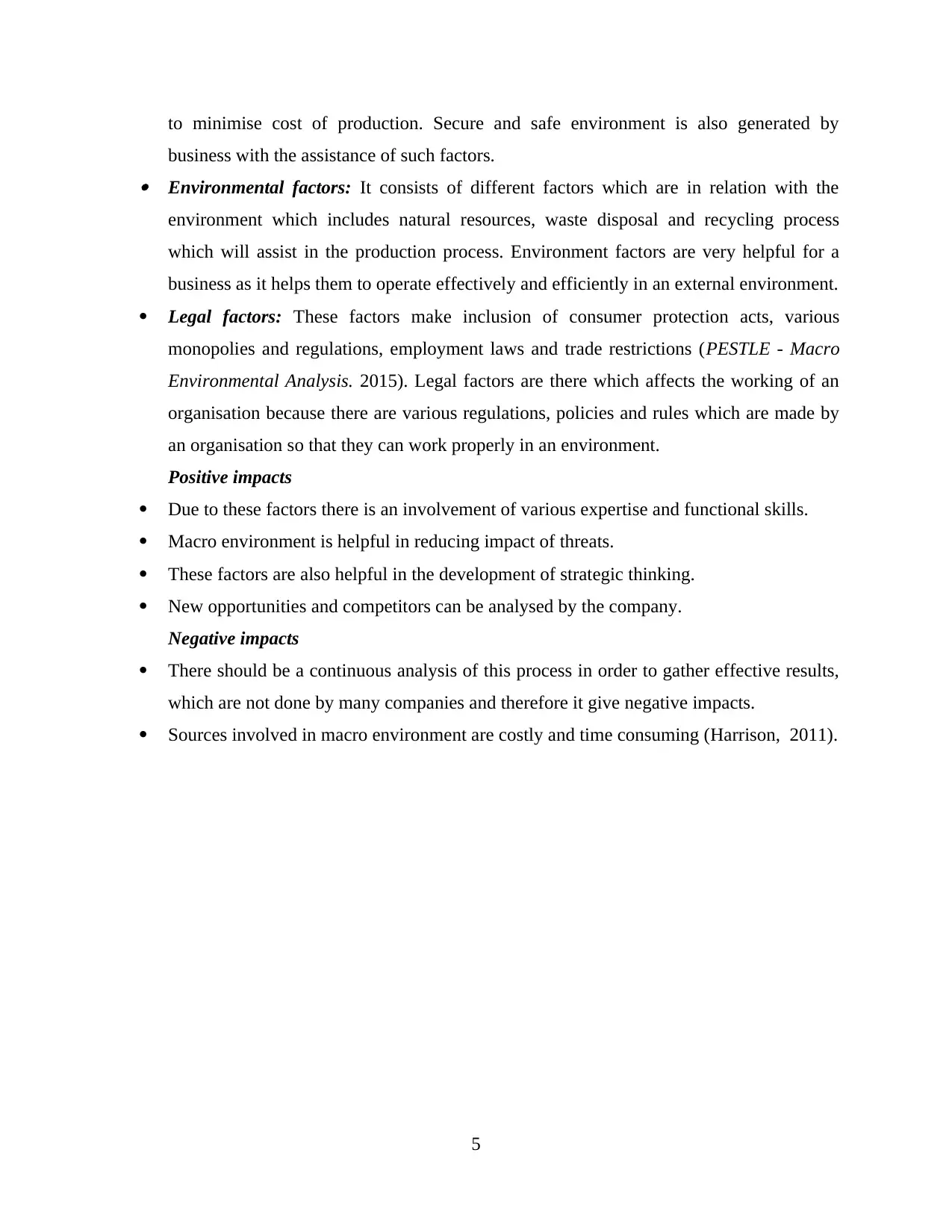
to minimise cost of production. Secure and safe environment is also generated by
business with the assistance of such factors. Environmental factors: It consists of different factors which are in relation with the
environment which includes natural resources, waste disposal and recycling process
which will assist in the production process. Environment factors are very helpful for a
business as it helps them to operate effectively and efficiently in an external environment.
Legal factors: These factors make inclusion of consumer protection acts, various
monopolies and regulations, employment laws and trade restrictions (PESTLE - Macro
Environmental Analysis. 2015). Legal factors are there which affects the working of an
organisation because there are various regulations, policies and rules which are made by
an organisation so that they can work properly in an environment.
Positive impacts
Due to these factors there is an involvement of various expertise and functional skills.
Macro environment is helpful in reducing impact of threats.
These factors are also helpful in the development of strategic thinking.
New opportunities and competitors can be analysed by the company.
Negative impacts
There should be a continuous analysis of this process in order to gather effective results,
which are not done by many companies and therefore it give negative impacts.
Sources involved in macro environment are costly and time consuming (Harrison, 2011).
5
business with the assistance of such factors. Environmental factors: It consists of different factors which are in relation with the
environment which includes natural resources, waste disposal and recycling process
which will assist in the production process. Environment factors are very helpful for a
business as it helps them to operate effectively and efficiently in an external environment.
Legal factors: These factors make inclusion of consumer protection acts, various
monopolies and regulations, employment laws and trade restrictions (PESTLE - Macro
Environmental Analysis. 2015). Legal factors are there which affects the working of an
organisation because there are various regulations, policies and rules which are made by
an organisation so that they can work properly in an environment.
Positive impacts
Due to these factors there is an involvement of various expertise and functional skills.
Macro environment is helpful in reducing impact of threats.
These factors are also helpful in the development of strategic thinking.
New opportunities and competitors can be analysed by the company.
Negative impacts
There should be a continuous analysis of this process in order to gather effective results,
which are not done by many companies and therefore it give negative impacts.
Sources involved in macro environment are costly and time consuming (Harrison, 2011).
5
Paraphrase This Document
Need a fresh take? Get an instant paraphrase of this document with our AI Paraphraser

(Source: Macro environment, 2017)
P5 Internal and external analysis of an organisation
Change is a kind of inevitable part of an organisation, if a company know how to
maintain stock of strengths, opportunities, threats and weaknesses, then a business can act and
plan effectively. SWOT helps in providing tool which is needed to explore both external and
internal factors which will be influencing operations of a business. This kind of analysis is used
for identification of organisation weakness and strengths as well as broad opportunities and
threats. Developing full awareness of a particular situation will assist in decision making and
strategic planning (Haidar, 2012). ABC consultants make use of external and internal
environment in order to find its weaknesses and strengths. SWOT was basically developed for a
industry or a business and it provide full support to an organisation so as to make proper growth
and development.
6
I
llustration 2: Macro environment, 2017
P5 Internal and external analysis of an organisation
Change is a kind of inevitable part of an organisation, if a company know how to
maintain stock of strengths, opportunities, threats and weaknesses, then a business can act and
plan effectively. SWOT helps in providing tool which is needed to explore both external and
internal factors which will be influencing operations of a business. This kind of analysis is used
for identification of organisation weakness and strengths as well as broad opportunities and
threats. Developing full awareness of a particular situation will assist in decision making and
strategic planning (Haidar, 2012). ABC consultants make use of external and internal
environment in order to find its weaknesses and strengths. SWOT was basically developed for a
industry or a business and it provide full support to an organisation so as to make proper growth
and development.
6
I
llustration 2: Macro environment, 2017
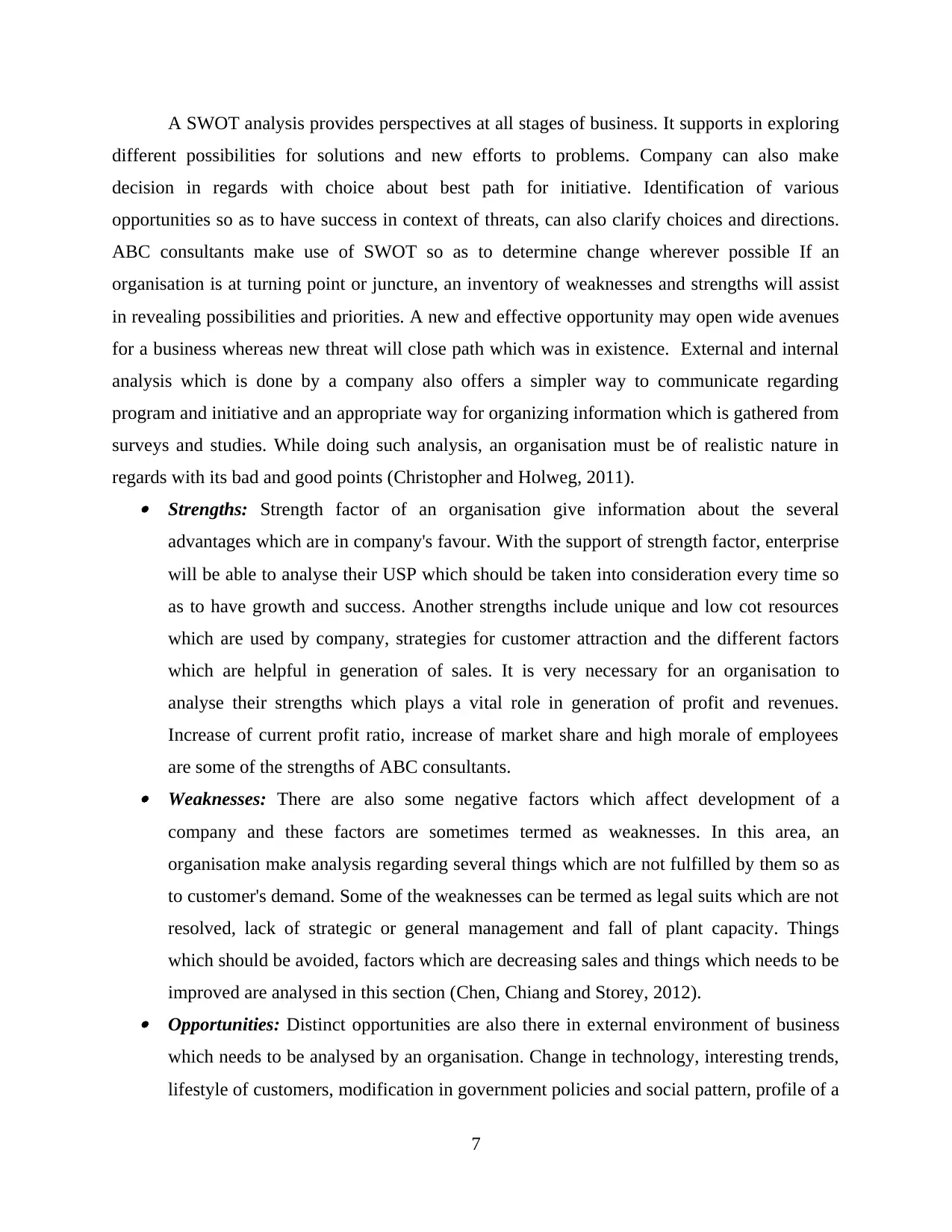
A SWOT analysis provides perspectives at all stages of business. It supports in exploring
different possibilities for solutions and new efforts to problems. Company can also make
decision in regards with choice about best path for initiative. Identification of various
opportunities so as to have success in context of threats, can also clarify choices and directions.
ABC consultants make use of SWOT so as to determine change wherever possible If an
organisation is at turning point or juncture, an inventory of weaknesses and strengths will assist
in revealing possibilities and priorities. A new and effective opportunity may open wide avenues
for a business whereas new threat will close path which was in existence. External and internal
analysis which is done by a company also offers a simpler way to communicate regarding
program and initiative and an appropriate way for organizing information which is gathered from
surveys and studies. While doing such analysis, an organisation must be of realistic nature in
regards with its bad and good points (Christopher and Holweg, 2011). Strengths: Strength factor of an organisation give information about the several
advantages which are in company's favour. With the support of strength factor, enterprise
will be able to analyse their USP which should be taken into consideration every time so
as to have growth and success. Another strengths include unique and low cot resources
which are used by company, strategies for customer attraction and the different factors
which are helpful in generation of sales. It is very necessary for an organisation to
analyse their strengths which plays a vital role in generation of profit and revenues.
Increase of current profit ratio, increase of market share and high morale of employees
are some of the strengths of ABC consultants. Weaknesses: There are also some negative factors which affect development of a
company and these factors are sometimes termed as weaknesses. In this area, an
organisation make analysis regarding several things which are not fulfilled by them so as
to customer's demand. Some of the weaknesses can be termed as legal suits which are not
resolved, lack of strategic or general management and fall of plant capacity. Things
which should be avoided, factors which are decreasing sales and things which needs to be
improved are analysed in this section (Chen, Chiang and Storey, 2012). Opportunities: Distinct opportunities are also there in external environment of business
which needs to be analysed by an organisation. Change in technology, interesting trends,
lifestyle of customers, modification in government policies and social pattern, profile of a
7
different possibilities for solutions and new efforts to problems. Company can also make
decision in regards with choice about best path for initiative. Identification of various
opportunities so as to have success in context of threats, can also clarify choices and directions.
ABC consultants make use of SWOT so as to determine change wherever possible If an
organisation is at turning point or juncture, an inventory of weaknesses and strengths will assist
in revealing possibilities and priorities. A new and effective opportunity may open wide avenues
for a business whereas new threat will close path which was in existence. External and internal
analysis which is done by a company also offers a simpler way to communicate regarding
program and initiative and an appropriate way for organizing information which is gathered from
surveys and studies. While doing such analysis, an organisation must be of realistic nature in
regards with its bad and good points (Christopher and Holweg, 2011). Strengths: Strength factor of an organisation give information about the several
advantages which are in company's favour. With the support of strength factor, enterprise
will be able to analyse their USP which should be taken into consideration every time so
as to have growth and success. Another strengths include unique and low cot resources
which are used by company, strategies for customer attraction and the different factors
which are helpful in generation of sales. It is very necessary for an organisation to
analyse their strengths which plays a vital role in generation of profit and revenues.
Increase of current profit ratio, increase of market share and high morale of employees
are some of the strengths of ABC consultants. Weaknesses: There are also some negative factors which affect development of a
company and these factors are sometimes termed as weaknesses. In this area, an
organisation make analysis regarding several things which are not fulfilled by them so as
to customer's demand. Some of the weaknesses can be termed as legal suits which are not
resolved, lack of strategic or general management and fall of plant capacity. Things
which should be avoided, factors which are decreasing sales and things which needs to be
improved are analysed in this section (Chen, Chiang and Storey, 2012). Opportunities: Distinct opportunities are also there in external environment of business
which needs to be analysed by an organisation. Change in technology, interesting trends,
lifestyle of customers, modification in government policies and social pattern, profile of a
7
⊘ This is a preview!⊘
Do you want full access?
Subscribe today to unlock all pages.

Trusted by 1+ million students worldwide

population are some of the opportunities which are determined (Cavalcante, Kesting and
Ulhøi, 2011).
Threats: It is very significant to make determination of threats as it affects company in
negative way which hinder its success and growth. Information regarding bad debt or
cash flow, different obstacles which are faced by ABC consultants, quality standards and
change specifications or any other kind of weakness are termed as some of the threats of
a company. Low value of dollars, expensive resources can also be said as organisation's
threat.
P6 Interrelation of internal as well as external macro environment
Analysis of external as well as internal environment is a vital part of a company as it will
support in determining external environment of a business in which they are operating and
internal strengths and weaknesses of a company so that they can work with efficiency and
effectiveness. The market in which company operates is defined as the area where each and
every customer of a company is making use of services and products. With the support of the
PESTLE analysis, organisation's external environment which makes inclusion of demographic,
economic etc. factors is analysed (Carroll and Shabana, 2010). SWOT analysis which is termed
as internal or micro analysis will be supportive for a company as it will helps in analysing
different threats and opportunities. Different opportunities are there which assist in finding
innovative ideas, market change, technology development for company's growth. Threats are
termed as the external factors who are having there existence in supply chain are uncontrollable
and are determined with the analysis of micro environment.
Several government regulations and policies which are affecting operations of business,
also help in controlling and monitoring organisation's operations which can be analysed by
macro factors. Managers who are having responsibility for making strategies should be aware
different statutory issues and laws in order to make effective strategies and policies. Evaluation
of various socio-cultural factors must be there which is needed to identify implementation of
various business policies. Technological factor assist in adopting new technologies, knowledge
and skills and material needed for production of goods and services. It is very necessary to
determine such factors as they affects the smooth running of an organisation (Cantwell, Dunning
and Lundan, 2010).
8
Ulhøi, 2011).
Threats: It is very significant to make determination of threats as it affects company in
negative way which hinder its success and growth. Information regarding bad debt or
cash flow, different obstacles which are faced by ABC consultants, quality standards and
change specifications or any other kind of weakness are termed as some of the threats of
a company. Low value of dollars, expensive resources can also be said as organisation's
threat.
P6 Interrelation of internal as well as external macro environment
Analysis of external as well as internal environment is a vital part of a company as it will
support in determining external environment of a business in which they are operating and
internal strengths and weaknesses of a company so that they can work with efficiency and
effectiveness. The market in which company operates is defined as the area where each and
every customer of a company is making use of services and products. With the support of the
PESTLE analysis, organisation's external environment which makes inclusion of demographic,
economic etc. factors is analysed (Carroll and Shabana, 2010). SWOT analysis which is termed
as internal or micro analysis will be supportive for a company as it will helps in analysing
different threats and opportunities. Different opportunities are there which assist in finding
innovative ideas, market change, technology development for company's growth. Threats are
termed as the external factors who are having there existence in supply chain are uncontrollable
and are determined with the analysis of micro environment.
Several government regulations and policies which are affecting operations of business,
also help in controlling and monitoring organisation's operations which can be analysed by
macro factors. Managers who are having responsibility for making strategies should be aware
different statutory issues and laws in order to make effective strategies and policies. Evaluation
of various socio-cultural factors must be there which is needed to identify implementation of
various business policies. Technological factor assist in adopting new technologies, knowledge
and skills and material needed for production of goods and services. It is very necessary to
determine such factors as they affects the smooth running of an organisation (Cantwell, Dunning
and Lundan, 2010).
8
Paraphrase This Document
Need a fresh take? Get an instant paraphrase of this document with our AI Paraphraser

Macro environment also includes demographic forces, in which there are different market
segments which are affected by common demographic forces and includes age, ethnicity, region,
education level, cultural characteristic, lifestyles and movements. Economic factor which is a
part of external environment impact decision making process of consumers and production
process of an organisation (Boons and Lüdeke-Freund, 2013). Natural forces includes marine
products, agriculture products and forests which should be considered by a company while
performing its operations. The impact of ABC consultants services and products is also there on
society. Any kind of element which is in relation with production process and is harmful for
society should be eliminated in order to show that organisation is taking responsibility of society.
Micro environment consists of resellers, suppliers, customers etc. who plays a role in the
success of an organisation. Success of a business is controlled by supplier when they hold power.
And power is being hold by supplier when they are the largest and only supplier of goods.
Reason for buying a product by consumer plays a large role in determining, what kind of
marketing approaches should be used by company for marketing their services and products.
Competitors are the persons who are selling similar or same services and products and the way
which is used by them to sell must be taken into account by an organisation. It may include their
product and price differentiation which may impact company. It also includes general public,
who must be satisfied by an organisation (Arasti and et.al,. 2014). Any action which is taken by a
company should be considered from general public's angle and how that action is affecting them.
Public has the power which assist company in reaching goals.
CONCLUSION
Business environment is one of the main need of an organisation which needs to analysed
by a company in order to have success. From the above report it can be analysed that analysis of
business environment must be done by ABC consultants so that they will get aware of the
various macro and micro factors which affect business in a way or other. Company use various
strategies and tactics for evaluating business environment. By analysing strengths, weakness,
opportunities and threats, company can make changes in the process of production so as to
satisfy needs and requirement of customers. It has also been evaluated that organisation's
functions gets affected by organisational chart and helps in the coordination of several
departments.
9
segments which are affected by common demographic forces and includes age, ethnicity, region,
education level, cultural characteristic, lifestyles and movements. Economic factor which is a
part of external environment impact decision making process of consumers and production
process of an organisation (Boons and Lüdeke-Freund, 2013). Natural forces includes marine
products, agriculture products and forests which should be considered by a company while
performing its operations. The impact of ABC consultants services and products is also there on
society. Any kind of element which is in relation with production process and is harmful for
society should be eliminated in order to show that organisation is taking responsibility of society.
Micro environment consists of resellers, suppliers, customers etc. who plays a role in the
success of an organisation. Success of a business is controlled by supplier when they hold power.
And power is being hold by supplier when they are the largest and only supplier of goods.
Reason for buying a product by consumer plays a large role in determining, what kind of
marketing approaches should be used by company for marketing their services and products.
Competitors are the persons who are selling similar or same services and products and the way
which is used by them to sell must be taken into account by an organisation. It may include their
product and price differentiation which may impact company. It also includes general public,
who must be satisfied by an organisation (Arasti and et.al,. 2014). Any action which is taken by a
company should be considered from general public's angle and how that action is affecting them.
Public has the power which assist company in reaching goals.
CONCLUSION
Business environment is one of the main need of an organisation which needs to analysed
by a company in order to have success. From the above report it can be analysed that analysis of
business environment must be done by ABC consultants so that they will get aware of the
various macro and micro factors which affect business in a way or other. Company use various
strategies and tactics for evaluating business environment. By analysing strengths, weakness,
opportunities and threats, company can make changes in the process of production so as to
satisfy needs and requirement of customers. It has also been evaluated that organisation's
functions gets affected by organisational chart and helps in the coordination of several
departments.
9
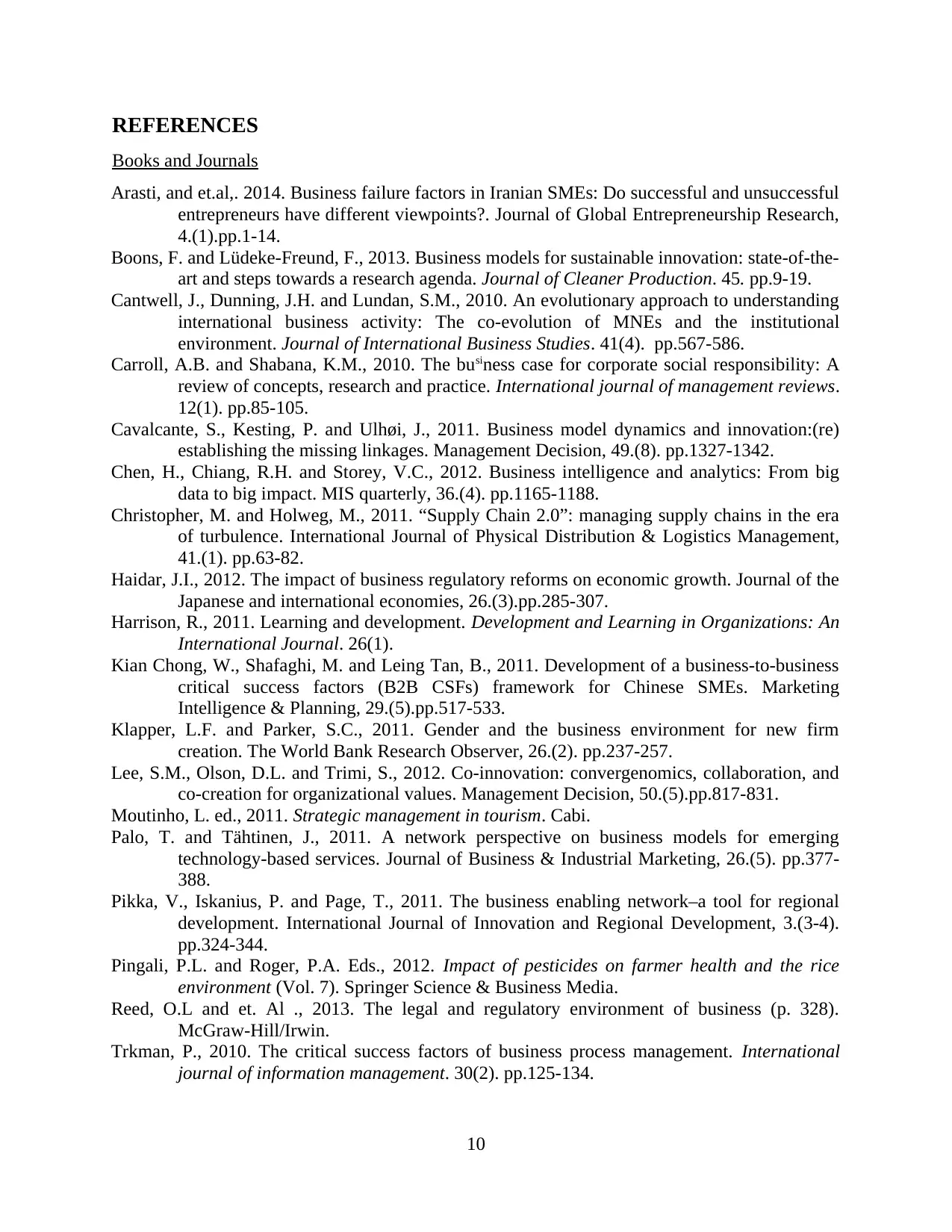
REFERENCES
Books and Journals
Arasti, and et.al,. 2014. Business failure factors in Iranian SMEs: Do successful and unsuccessful
entrepreneurs have different viewpoints?. Journal of Global Entrepreneurship Research,
4.(1).pp.1-14.
Boons, F. and Lüdeke-Freund, F., 2013. Business models for sustainable innovation: state-of-the-
art and steps towards a research agenda. Journal of Cleaner Production. 45. pp.9-19.
Cantwell, J., Dunning, J.H. and Lundan, S.M., 2010. An evolutionary approach to understanding
international business activity: The co-evolution of MNEs and the institutional
environment. Journal of International Business Studies. 41(4). pp.567-586.
Carroll, A.B. and Shabana, K.M., 2010. The business case for corporate social responsibility: A
review of concepts, research and practice. International journal of management reviews.
12(1). pp.85-105.
Cavalcante, S., Kesting, P. and Ulhøi, J., 2011. Business model dynamics and innovation:(re)
establishing the missing linkages. Management Decision, 49.(8). pp.1327-1342.
Chen, H., Chiang, R.H. and Storey, V.C., 2012. Business intelligence and analytics: From big
data to big impact. MIS quarterly, 36.(4). pp.1165-1188.
Christopher, M. and Holweg, M., 2011. “Supply Chain 2.0”: managing supply chains in the era
of turbulence. International Journal of Physical Distribution & Logistics Management,
41.(1). pp.63-82.
Haidar, J.I., 2012. The impact of business regulatory reforms on economic growth. Journal of the
Japanese and international economies, 26.(3).pp.285-307.
Harrison, R., 2011. Learning and development. Development and Learning in Organizations: An
International Journal. 26(1).
Kian Chong, W., Shafaghi, M. and Leing Tan, B., 2011. Development of a business-to-business
critical success factors (B2B CSFs) framework for Chinese SMEs. Marketing
Intelligence & Planning, 29.(5).pp.517-533.
Klapper, L.F. and Parker, S.C., 2011. Gender and the business environment for new firm
creation. The World Bank Research Observer, 26.(2). pp.237-257.
Lee, S.M., Olson, D.L. and Trimi, S., 2012. Co-innovation: convergenomics, collaboration, and
co-creation for organizational values. Management Decision, 50.(5).pp.817-831.
Moutinho, L. ed., 2011. Strategic management in tourism. Cabi.
Palo, T. and Tähtinen, J., 2011. A network perspective on business models for emerging
technology-based services. Journal of Business & Industrial Marketing, 26.(5). pp.377-
388.
Pikka, V., Iskanius, P. and Page, T., 2011. The business enabling network–a tool for regional
development. International Journal of Innovation and Regional Development, 3.(3-4).
pp.324-344.
Pingali, P.L. and Roger, P.A. Eds., 2012. Impact of pesticides on farmer health and the rice
environment (Vol. 7). Springer Science & Business Media.
Reed, O.L and et. Al ., 2013. The legal and regulatory environment of business (p. 328).
McGraw-Hill/Irwin.
Trkman, P., 2010. The critical success factors of business process management. International
journal of information management. 30(2). pp.125-134.
10
Books and Journals
Arasti, and et.al,. 2014. Business failure factors in Iranian SMEs: Do successful and unsuccessful
entrepreneurs have different viewpoints?. Journal of Global Entrepreneurship Research,
4.(1).pp.1-14.
Boons, F. and Lüdeke-Freund, F., 2013. Business models for sustainable innovation: state-of-the-
art and steps towards a research agenda. Journal of Cleaner Production. 45. pp.9-19.
Cantwell, J., Dunning, J.H. and Lundan, S.M., 2010. An evolutionary approach to understanding
international business activity: The co-evolution of MNEs and the institutional
environment. Journal of International Business Studies. 41(4). pp.567-586.
Carroll, A.B. and Shabana, K.M., 2010. The business case for corporate social responsibility: A
review of concepts, research and practice. International journal of management reviews.
12(1). pp.85-105.
Cavalcante, S., Kesting, P. and Ulhøi, J., 2011. Business model dynamics and innovation:(re)
establishing the missing linkages. Management Decision, 49.(8). pp.1327-1342.
Chen, H., Chiang, R.H. and Storey, V.C., 2012. Business intelligence and analytics: From big
data to big impact. MIS quarterly, 36.(4). pp.1165-1188.
Christopher, M. and Holweg, M., 2011. “Supply Chain 2.0”: managing supply chains in the era
of turbulence. International Journal of Physical Distribution & Logistics Management,
41.(1). pp.63-82.
Haidar, J.I., 2012. The impact of business regulatory reforms on economic growth. Journal of the
Japanese and international economies, 26.(3).pp.285-307.
Harrison, R., 2011. Learning and development. Development and Learning in Organizations: An
International Journal. 26(1).
Kian Chong, W., Shafaghi, M. and Leing Tan, B., 2011. Development of a business-to-business
critical success factors (B2B CSFs) framework for Chinese SMEs. Marketing
Intelligence & Planning, 29.(5).pp.517-533.
Klapper, L.F. and Parker, S.C., 2011. Gender and the business environment for new firm
creation. The World Bank Research Observer, 26.(2). pp.237-257.
Lee, S.M., Olson, D.L. and Trimi, S., 2012. Co-innovation: convergenomics, collaboration, and
co-creation for organizational values. Management Decision, 50.(5).pp.817-831.
Moutinho, L. ed., 2011. Strategic management in tourism. Cabi.
Palo, T. and Tähtinen, J., 2011. A network perspective on business models for emerging
technology-based services. Journal of Business & Industrial Marketing, 26.(5). pp.377-
388.
Pikka, V., Iskanius, P. and Page, T., 2011. The business enabling network–a tool for regional
development. International Journal of Innovation and Regional Development, 3.(3-4).
pp.324-344.
Pingali, P.L. and Roger, P.A. Eds., 2012. Impact of pesticides on farmer health and the rice
environment (Vol. 7). Springer Science & Business Media.
Reed, O.L and et. Al ., 2013. The legal and regulatory environment of business (p. 328).
McGraw-Hill/Irwin.
Trkman, P., 2010. The critical success factors of business process management. International
journal of information management. 30(2). pp.125-134.
10
⊘ This is a preview!⊘
Do you want full access?
Subscribe today to unlock all pages.

Trusted by 1+ million students worldwide
1 out of 13
Related Documents
Your All-in-One AI-Powered Toolkit for Academic Success.
+13062052269
info@desklib.com
Available 24*7 on WhatsApp / Email
![[object Object]](/_next/static/media/star-bottom.7253800d.svg)
Unlock your academic potential
Copyright © 2020–2025 A2Z Services. All Rights Reserved. Developed and managed by ZUCOL.





